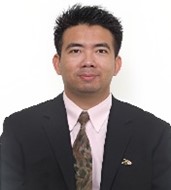Keynote Speaker I
Prof. Ahmad Zuhairi Abdullah, University Sains Malaysia, Malaysia |
Biography: Professor Dr Ahmad Zuhairi Abdullah received his B. Tech (Hons), MSc, and PhD in 1995, 2000, and 2004, respectively. He was the Deputy Dean (Industry and Community Network) at the School of Chemical Engineering, Universiti Sains Malaysia between 2010-2012 and Deputy Dean (Research and Postgraduate Studies) between 2013-2018. He is also serving his deanship of the school in 2022-2024. He is registered as a Professional Technologist at Malaysian Board of Technologists (MBOT), a Fellow Member of Institut Kimia Malaysia (IKM) and a Life member of the Malaysian Oil Scientists and Technologists’ Association (MOSTA). He is regularly appointed as an MBOT accreditation auditor and as a program’s external examiner for many academic programs in several Malaysian universities. His research works mostly involve the use of ordered porous catalytic materials in oleochemical reactions, renewable energy, waste treatment, and waste valorization. He has nearly 300 refereed publications in journals and book/book chapters mainly as the main author, and also involves as a technical committee member of nearly 150 international scientific conferences. He is often invited to share his research experiences at various international conferences held in Malaysia, Laos, Indonesia, Vietnam, Thailand, Pakistan, The Philippines, and PR China. In addition, he is an evaluator for research proposals from different ministries/agencies locally as well as from several international scientific bodies in the EU, USA, Oman, Qatar, Kazakhstan, and Chile. He is also an expert panel of the Department of Environment Malaysia for the evaluation of Environmental Impact Assessment reports for various proposed commercial projects related to petrochemical complexes, paper mills, metal smelting, chemical, lead-acid battery recycling plants, etc. He is one of the recipients of the Top Research Scientists Malaysia (TRSM) award in 2014 and was listed in the List of World’s Top 2% Scientists by Stanford University in 2020-2022. His h-index (Scopus) currently stands at 59 with around 12,000 citations. Talk titled: Oleochemical waste valorization: Glycerol conversion to value-added chemicals using heterogeneous catalytic processes for sustainable industries |
Keynote Speaker II
Prof. Tonni Agustiono Kurniawan, Xiamen University, China |
Biography: Dr. T.A. Kurniawan is a recognized global leader in tackling complex environmental problems that have significant societal relevance and positive impact in the world. His research interests are in the areas of wastewater treatment and solid waste management. To date, Kurniawan is the first author of 20% of the works with an h-index of 60 and citations of over 14,500 counts (Scopus), while being the corresponding author of one third of the same works. The scientific contributions are tangible manifestations of his competence and research impact in the discipline. Talk titled: Recovering heavy metals from electroplating wastewater and their conversion into Zn2Cr-layered double hydroxide (LDH) for pyrophosphate removal from industrial wastewater |

